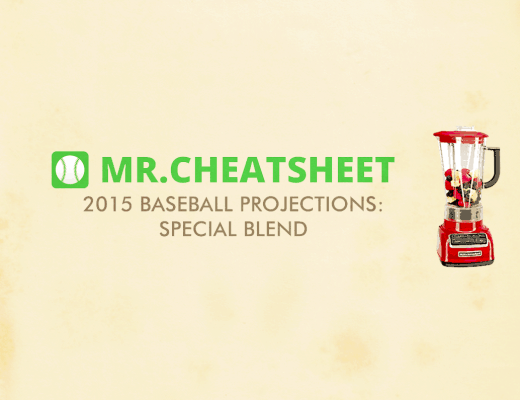There’s a lot of specialists within the world of baseball and fantasy sports that add to the richness of our collective knowledge. The folks at Steamer Projections represent the keepers of knowledge when it comes to accurate player projections.
While Steamer is one of the newer projection systems in that world, Jared Cross, Peter Rosenbloom and Dash Davidson have wasted no time in making their system into the most accurate projection system for both hitters and pitchers year after year. As word grew about how accurate Steamer has been, the popularity of the system grew along with it. Steamer has since become the default projection system used by many sites including the wildly popular Fangraphs and Jared has even gone on to write pieces for ESPN.com.
I got the pleasure of getting to ask Jared some questions and learn a bit about Steamer’s past, present and future.
Steamer has become well-known to the baseball nerd community but we often forget that there are actual people behind the system. Tell us a bit about yourself and your background.
I’m a high school math and science teacher in Brooklyn, New York with two kids (2 and 4 years old) and a wife who puts up with my spending way to much time playing around with baseball statistics. Dash Davidson and Peter Rosenbloom, who will graduate from college in a couple of months, were my Chemistry students way back when they were in 10th grade and we decided to start working on this project. Peter takes his forecasting talents to J.P. Morgan in the fall and Dash is still weighing his post-college options and looking to get a job in baseball.
Why did you name it Steamer?
Our school’s sports teams are called the Steamers and we’d all played on the Steamers baseball team and, also, we’re not that creative.
You are in a grey area where two seemingly unrelated things, math and baseball, meet. Are you more of a baseball fan or a fan of statistics?
My interest in statistics was spurred by my interest in baseball but I’m a fan of statistics in it’s own right now. Really, they’re perfect together. Beer and tacos or something like that.
How did Steamer come to be? What was the goal?
The goal was initially to figure out how to win at fantasy baseball (for the record, Dash and I have consistently won our leagues — Peter not so much) and morphed into a project to create our own projections. We started by imitating Marcel and then, after the first year, began adding features and layers of complication one at a time.
So you were aware of Marcel. What about CHONE and ZiPS from that time as well?
We knew the algorithm for Marcel and started there and we knew about some of the features that CHONE and ZiPS and others systems add to the Marcel model, like using park factors and minor league equivalents. Those were some of the first additions we made to our original model. We still don’t know everything those guys are up to, of course.
What was your biggest “eureka!” moment with Steamer?
I think it’s the realization that regression to the mean is a stand in for Bayes’ theorem and, therefore, that the baseline that we want to regress each player’s statistics towards is really a “prior” — something like our best guess as to his ability before we know his stats.
What has been the hardest thing for you to accurately project?
Playing time and injuries, I think.
What data or stat do you wish you had access to (whether it exists or not) in order to improve upon your projections?
For the first time this year, we have access to Inside Edge data which includes the location and hang time for batted balls and I’m excited about what we might be able to do with that. I’d love to have data on how deceptive pitchers’ motions are and how much their changeups looks like their fastballs. It would be incredible if we knew how hard every player works in the offseason and had medical reports that indicated their physiological age.
You have made changes each year to Steamer but are there things you hoped to add that you haven’t gotten to yet?
We’d like to make long-term projections at some point. We’d also like to project platoon splits for pitchers (we have platoon splits for hitters now although they aren’t published anywhere) and be able to make a projections for individual batter-pitcher matchups. There are also ways we think we can make the projections we do have more accurate, by utilizing the Inside Edge data and by using pitchf/x data more fully among other things.
Are you aware of any sort of secret projection systems that MLB teams are using? Do you think your methodology could benefit a real ballclub?
I really don’t know. I saw Jeff Lunhow describe the Astros internal projection system as “best in class” and I’d love to know what they’re up to.
Do you play fantasy baseball? If so, how obsessive are you about it? And, do you use your own projections?
Yes, although not like I used. A friend and I used to co-manage a dynasty team in a league with a 40-man roster and another 40 minor leaguers, long-term contracts, options and arbitration and all of that. At that point, we could recite scouting reports on any top prospect including kids still in high school. That had to end when I had kids. Now I play in a low stakes, relatively easy-going league. I do use Steamer.
For those that use Steamer for fantasy baseball purposes, are there any tips you’d like to give them about the pros and cons of relying solely on the projections?
That’s tricky. If you’re thinking about how much weight to give data from different years in the past or how to adjust for a move to a new ballpark, I’d suggest that this is the kind of thing an algorithm is relatively good at and that you’re probably better off trusting Steamer (or whichever system you prefer) than your own instincts. If, however, you happen to know that player X is nursing a quad injury and won’t steal nearly as many bases as he did in the past, then you know something Steamer doesn’t and should adjust accordingly.
If you go back to when you were first starting Steamer, what is one thing you wish you could tell yourself?
I’d tell myself to learn R and SQL right away.
Where do you see Steamer five years from now (if you think it will still exist)?
I hope it still exists and that it’s a good bit better than it is now and that we’re still looking for and finding ways to improve it.
In closing, I like to ask a pretty divisive question… What’s your favorite baseball movie and why?
The Natural. I don’t know why. The music? It’s more like a dream than a movie and I spent a lot of time dreaming about baseball a kid. Also, he starts out as a kid playing catch with his dad and ends the movie playing catch with his own kid. That’s really what baseball is all about.



